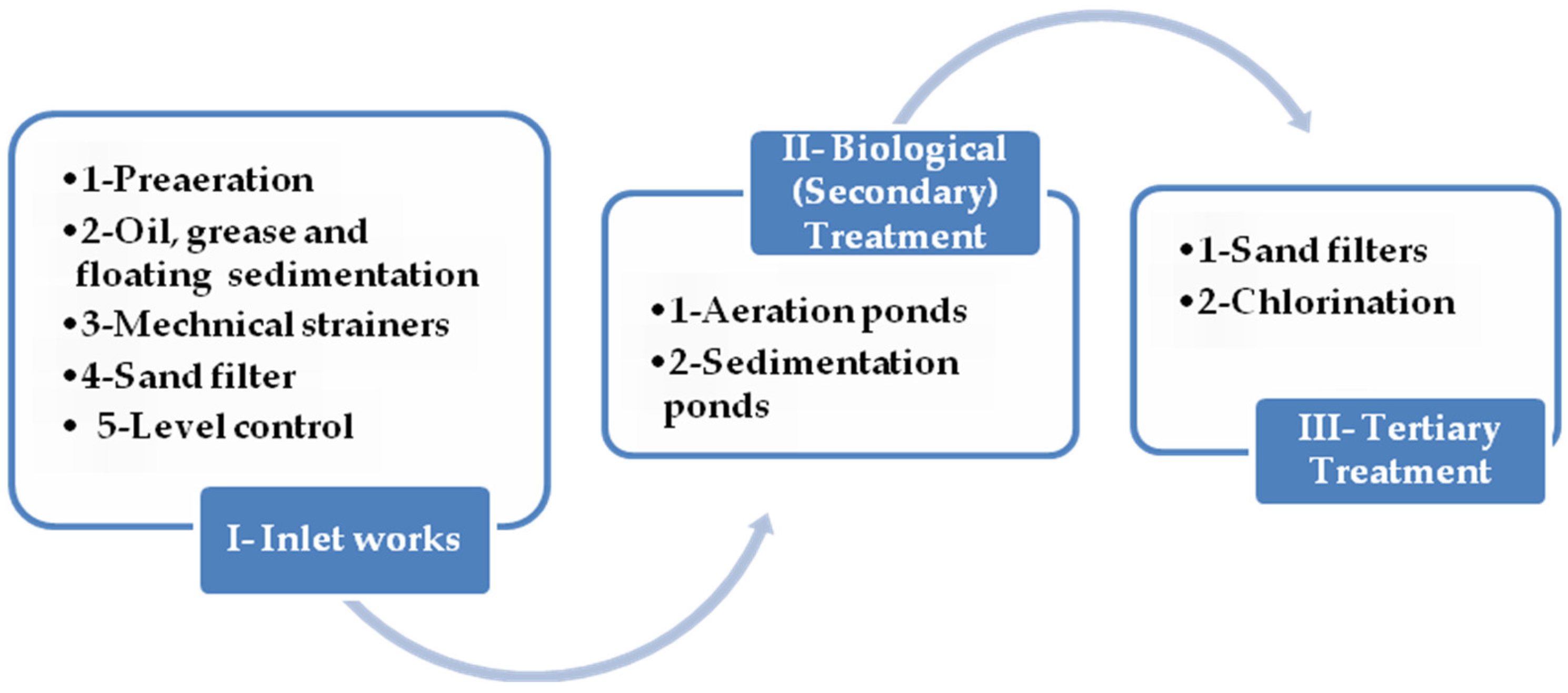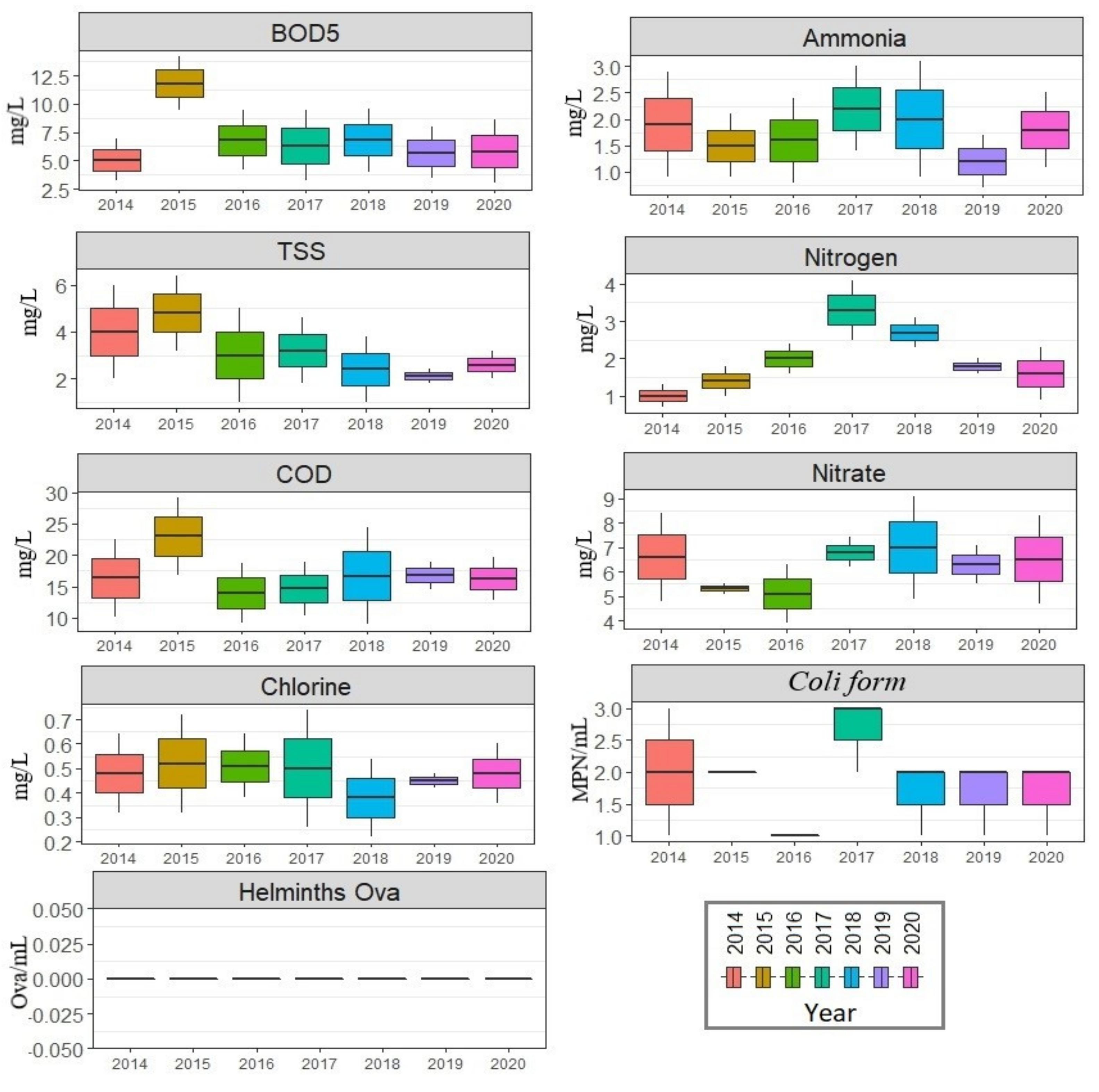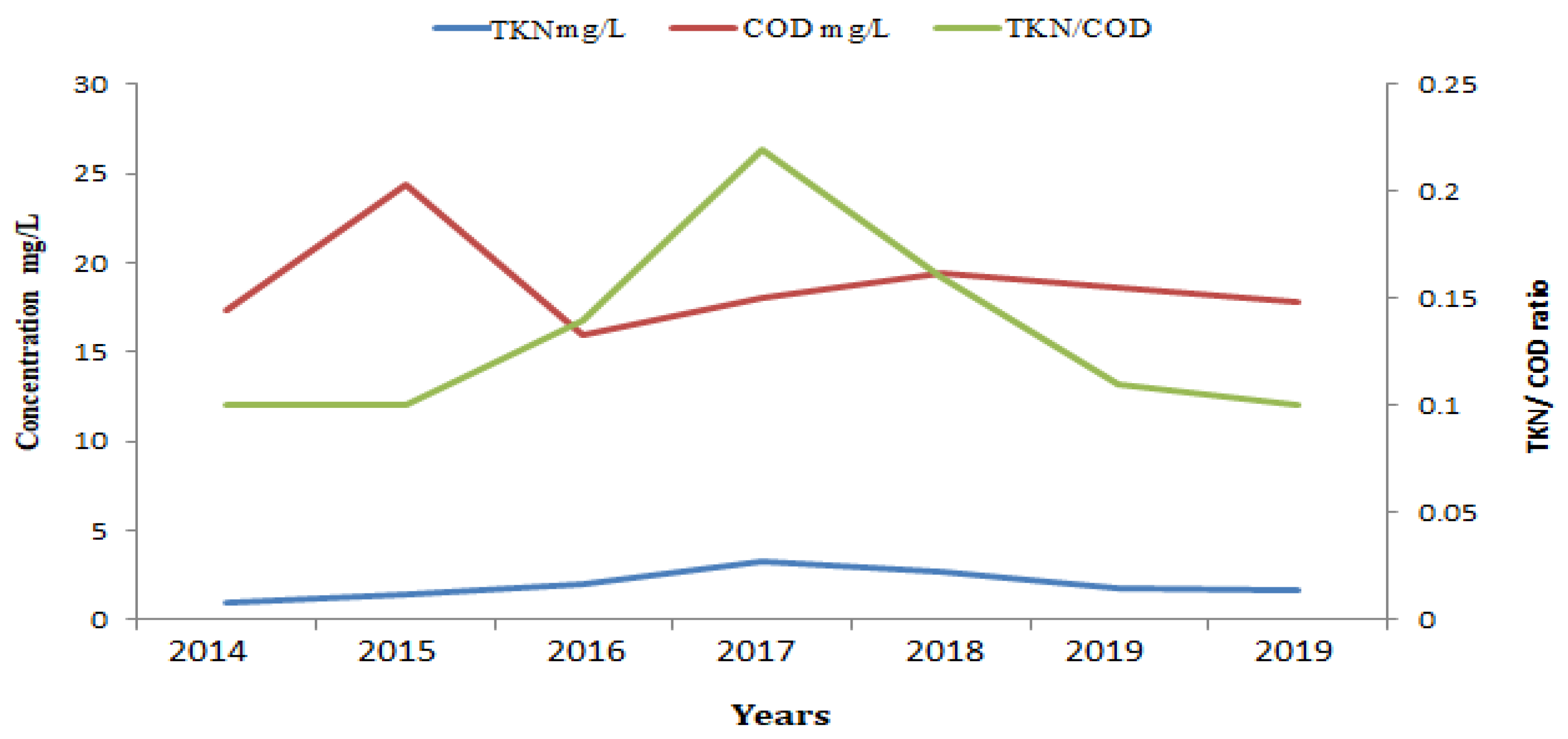Oxidation Ditches for Recycling and Reusing Wastewater Are Critical for Long-Term Sustainability—A Case Study
Abstract
1. Introduction
2. Materials and Methods
- Aeration tank volume: 4200 m3
- Detention time: 1.45 day
- Sludge age: 20 day
- MLVSS: 2868 mg/L
- MLSS: 3824 mg/L
- F/M ratio: 0.13 mg BOD5/mg MLVSS
- Waste sludge flow: 0.248 mg/d
- TSS in waste sludge: 10.920 mg/L
- Waste sludge: 3920 mg/L (TSS)
- Return sludge flow: 50.47% of raw wastewater
- Aeration horsepower: 73.76 hp
- The oxidation ditch was designed for the following influent loadings:
- o
- Design influent flow: 14.400 m3/day
- o
- Influent BOD5 concentration: 383 mg/L
- o
- Influent TSS concentration: 242 mg/L
- o
- Influent ammonia concentration: 72 mg/L
2.1. Inlet Works
- Preparation: Oxidize the gases resulting from activity of the anaerobic bacteria inside the pipes and helps to float oils, fats, and greases.
- Oil, grease, and floating materials separation unit: The oil collection well is cleaned regularly, and the quantities that are collected are emptied into its own container and discharged continuously in the places designated for it.
- Mechanical strainers: Ensure the cleanliness of the mechanical filters and the non-accumulation of solid and large-sized wastes on the rods of the strainers.
- Sand filter: The filter medium is usually a mix of coarse and soft sand. The recommended effective media size (ES) range is 0.75 to 2.0 mm, and the uniformity coefficient (UC) should be less than 4.
- Flow meter: Should be regularly calibrated for accurate and proper operation.
2.2. Biological or Secondary Treatment, which Consists of
- Aeration ponds: Controlled dissolved oxygen to activate the aerobic bacteria in order to set a parameter (F/M) which is the percentage of bacteria with the amount of organic load in the wastewater.
- Sedimentation ponds: In which bacterial cells are deposited at the bottom of the sedimentation pond and the clear waters regularly overflow through V-shaped holes. On the surface of the water in the sedimentation basin, there is an upper scraper that removes the floating suspended solids collected on the surface of the pond.
2.3. Tertiary Treatment, Which Carried Out Through
- Sand filters: Receive the clear water from the sedimentation pond. The efficiency of the filter in terms of removing solid particles must be measured by measuring TSS of the water entering and leaving the filter.
- Chlorination: The appropriate chlorine dose (Kg/hour) is determined based on the amount of filtered water and the percentage of free chlorine remaining in the water as specified in the regulations.
2.4. Physico-Chemical Characteristics
2.5. Bacteriological Examinations
- Enumeration of total coliform by multiple tube fermentation (MTF) technique: Total coliform (TC) was determined using MTF technique according to APHA (2017).
- Presumptive test: Lauryl tryptose broth medium was used for presumptive test of TC. Appropriate three-decimal dilutions from each sample in three replicate tubes (ten tubes containing double strength of lauryl tryptose broth) were employed. The inoculated tubes were incubated at 37 ± 0.5 °C for 48 h, after which acid and gas production was recorded as positive presumptive test.
- Confirmed test: Brilliant green lactose bile broth (BGB) was used in the confirmatory test. Tubes containing BGB were inoculated with the positive presumptive tubes and incubated at 37 ± 0.5 °C for 48 h. The production of acid and gas was recorded as a positive confirmative test for TC. Referring to MPN tables for three rows of tube dilutions, the results were reported as MPN-index of confirmed TC per 100 mL of sample.
- Enumeration of E. coli: E. coli was detected by adding a few drops of kovacs reagent on positive EC broth tubes. The results were calculated according to three tubes of MPN table and expressed as MPN-index/100 mL.
2.6. Helminths Eggs (Parasitology)
2.7. Statistical Analysis
3. Results and Discussion
4. Conclusions
Author Contributions
Funding
Institutional Review Board Statement
Informed Consent Statement
Data Availability Statement
Conflicts of Interest
References
- FAO. Food and Agricultural Organization, Wastewater Treatment. 2006. Available online: http://www.fao.org/docrep/t0551e/t0551e06.htm#TopOfPage (accessed on 8 January 2022).
- Amoatey, P.; Bani, R. Wastewater Management; Department of Agricultural Engineering, Faculty of Engineering Sciences, University of Ghana: Accra, Ghana, 2011; Available online: https://www.researchgate.net/publication/221911472 (accessed on 8 January 2022).
- Yuje, Q.; Jiandong, W.; Hai, O. The Application of Organic Ecological Technology in Residential Sewage Treatment. J. Environ. Prot. 2013, 4, 31–34. [Google Scholar]
- Wikaningrum, T.; Hakiki, R. Key performance indicators (KPIs) comparison of food chain reactor and conventional oxidation ditch technology in industrial waste treatment. J. Environ. Eng. Waste Manag. 2020, 5, 15–29. [Google Scholar] [CrossRef]
- Parker, R.; Morris, N.; Fair, F.N.; Bhatia, S.C. Waste-Water Engineering; CBS Publishers & Distributors Pvt Ltd.: New Delhi, India, 2018; p. 656. [Google Scholar]
- Al-Zubari, W.K. Impacts of groundwater over-exploitation on desertification of soils in Bahrain—A case study (1956–1992). In Proceedings of the International Conference on Regional Aquifer Systems in Arid Zones: Managing Non-Renewable Resources, Tripoli, Libya, 20–24 November 1999. [Google Scholar]
- Jakeman, A.J.; Barreteau, O.; Hunt, R.J.; Rinaudo, J.; Ross, A. Integrated Groundwater Management: Concepts, Approaches and Challenges; Springer International Publishing AG: Cham, Switzerland, 2016; p. 756. [Google Scholar] [CrossRef]
- Price, D.J.; Adams, C., Jr. Chapter 5—Water Use and Wastewater Management: Interrelated Issues with Unique Problems and Solutions. In Environmental and Health Issues in Unconventional Oil and Gas Development; Elsevier: Amsterdam, The Netherlands, 2016; pp. 61–79. [Google Scholar]
- Tchobanoglous, G.; Burton, F.L.; Stensel, H.D. Wastewater Engineering: Treatment and Resource Recovery, 5th ed.; McGraw-Hill Higher Education: New York, NY, USA; McGraw-Hill: London, UK, 2014. [Google Scholar]
- UNEP. Development of Performance Indicators for the Operation and Maintenance of Wastewater Treatment Plants and Wastewater Reuse; UNEP: Nairobi, Kenya, 2011. [Google Scholar]
- Hackworth, D. Process Optimization of Wastewater Treatment Plants. 2013. Available online: http://www.ohiowea.org/docs/Optimization_Wastewater_Utilities_Hackworth.pdf (accessed on 8 January 2022).
- Wennerholm, E. Performance Indicator Analysis as a Basis for Process Optimization and Energy Efficiency in Municipal Wastewater Treatment Plants; Uppsala University: Uppsala, Sweden, 2014; p. 66. [Google Scholar]
- Crini, G.; Lichtfouse, E. Wastewater Treatment: An Overview; Springer International Publishing AG: Cham, Switzerland, 2018; p. 18. [Google Scholar] [CrossRef]
- Shammas, N.K.; Wang, L.K. Oxidation Ditch. In Handbook of Environmental Engineering; CRC Press: Boca Raton, FL, USA, 2009; Volume 8, pp. 513–538. [Google Scholar]
- Wang, W.; Shi, C.; Yang, J.; Zeng, M.; Dai, Z.; Zhang, Z. Modelling performance of oxidation ditch in wastewater treatment plant by STOAT software. IOP Conf. Ser. Earth Environ. Sci. 2019, 300, 032065. [Google Scholar] [CrossRef]
- Peng, Y.; Hou, H.; Wang, S.; Cui, Y.; Yuan, Z. Nitrogen and Phosphorus Removal in Pilot-scale Anaerobic-Anoxic Oxidation Ditch System. J. Environ. Sci. 2008, 20, 398–403. [Google Scholar] [CrossRef]
- Hadisoebrotoa, R.; Kamila, I.M.; Notodarmojoa, S.; Bindarb, Y. Improving Performance of Water Treatment on Oxidation Ditch Using Modification of Reactor Hydrodynamic. J. Teknol. 2014, 69, 101–104. [Google Scholar] [CrossRef][Green Version]
- Wang, Z.Y.; Liu, C.M. Application and Development of Oxidation Ditch Process in Wastewater Treatment. Adv. Mater. Res. 2014, 955–959, 2397–2401. [Google Scholar] [CrossRef]
- Qiu, Y.; Zhang, C.; Li, B.; Li, J.; Zhang, X.; Liu, Y.; Liang, P.; Huang, X. Optimal Surface Aeration Control in Full-Scale Oxidation Ditches through Energy Consumption Analysis. Water 2018, 10, 945. [Google Scholar] [CrossRef]
- MWE. Technical Guidelines for the Use of Treated Sanitary Wastewater in Irrigation for Landscaping and Agricultural Irrigation; Ministry of Water and Electricity (MWE): Jubail, Saudi Arabia, 2006.
- APHA. Standard Methods for the Examination of Water and Wastewater, 23rd ed.; APHA: Washington, DC, USA, 2017; pp. 20001–23710. [Google Scholar]
- R Development Core Team. R: A Language and Environment for Statistical Computing; R Foundation for Statistical Computing: Vienna, Austria, 2014. [Google Scholar]
- Wickham, H. Package ggplot2, version 2.1; Create Elegant Data Visualisations Using the Grammar of Graphics; Springer International Publishing: Cham, Switzerland, 2016. [Google Scholar]
- Insel, G.; Artan, N.; Orhon, D. Effect of Aeration on Nutrient Removal Performance of Oxidation Ditch Systems. Environ. Eng. Sci. 2005, 22, 802–815. [Google Scholar] [CrossRef]
- Schwarzenbeck, N.; Bomball, E.; Pfeiffer, W. Can a wastewater treatment plant be a Power plant? A case study. Water Sci. Technol. 2008, 57, 1555–1561. [Google Scholar] [CrossRef]
- Mo, W.; Zhang, Q. Can municipal wastewater treatment systems be carbon neutral? J. Environ. Manag. 2012, 112, 360–367. [Google Scholar] [CrossRef]
- Gori, R.; Giaccherini, F.; Jiang, L.; Sobhani, R.; Rosso, D. Role of primary sedimentation on plant-wide energy recovery and carbon footprint. Water Sci. Technol. 2013, 68, 870–878. [Google Scholar] [CrossRef]
- Jenicek, P.; Kutil, J.; Benes, O.; Todt, V.; Zabranska, J.; Dohanyos, M. Energy self-sufficient sewage wastewater treatment plants: Is optimized anaerobic sludge digestion the key? Water Sci. Technol. 2013, 68, 1739–1744. [Google Scholar] [CrossRef]
- Tchobanoglous, G.; Burton, F.L.; Stensel, H.D. Wastewater Engineering: Treatment and Reuse, 4th ed.; Metcalf & Eddy Inc.: New York, NY, USA, 2003. [Google Scholar]
- Liu, Y.; Shi, H.; Xia, L.; Shi, H.; Shen, T.; Wang, Z.; Wang, G.; Wang, Y. Study of operational conditions of simultaneous nitrification and denitrification in a Carrousel oxidation ditch for domestic wastewater treatment. Bioresour. Technol. 2010, 101, 901–906. [Google Scholar] [CrossRef]
- EPA (United States Environmental Protection Agency). Wastewater Technology Fact Sheet, Oxidation Ditches; EPA: Washington, DC, USA, 2000.
- Rossle, W.H.; Pretorius, W.A. A review of characterization requirements for in-line prefermenters Paper 1: Wastewater characterization. Water SA 2001, 27, 405–412. [Google Scholar] [CrossRef][Green Version]
- Jia, W.; Wang, Q.; Zhang, J.; Yang, W.; Zhou, X. Nutrients removal and nitrous oxide emission during simultaneous nitrification, denitrification, and phosphorus removal process: Effect of iron. Environ. Sci. Pollut. Res. Int. 2016, 23, 15657–15664. [Google Scholar] [CrossRef] [PubMed]
- Kandare, G.; Viúdez-Moreiras, D.; Hernández-Del-Olmo, F. Adaptive control of the oxidation ditch reactors in a wastewater treatment plant. Int. J. Adapt. Control Signal Process. 2012, 26, 976–989. [Google Scholar] [CrossRef]
- Qiu, S.; Hu, Y.; Liu, R.; Sheng, X.; Chen, L.; Wu, G.; Hu, H.; Zhan, X. Start up of partial nitritation-anammox process using intermittently aerated sequencing batch reactor: Performance and microbial community dynamics. Sci. Total Environ. 2018, 647, 1188–1198. [Google Scholar] [CrossRef]
- Li, C.; Han, Z.; Zhang, Y.; Zheng, Y.; Zhang, H.; Fernandez-Rodriguez, E. Study on Sludge and Dissolved Oxygen Distribution in a Full-Scale A2/O Oxidation Ditch. Water 2021, 13, 2776. [Google Scholar] [CrossRef]
- WHO. Compendium of Standards for Wastewater Reuse in the Eastern Mediterranean Region, FAO Guidelines for Trace Metals in Irrigation Water; World Health Organization: Geneva, Switzerland, Regional Office for the Eastern Mediterranean: Cairo, Egypt; Regional Centre for Environmental Health Activities: Cairo, Egypt; 2006; Available online: https://applications.emro.who.int/dsaf/dsa1184.pdf (accessed on 8 January 2022).
- Davis-Colley, R.J.; Donnison, A.M.; Speed, D.J. Towards a mechanistic understanding of pond disinfection. Water Sci. Technol. 2000, 42, 149–158. [Google Scholar] [CrossRef]
- Ouali, A.; Jupsin, H.; Ghrabi, A.; Vasel, J.L. Removal kinetic of Escherichia coli and enterococci in a laboratory pilot scale wastewater maturation pond. Water Sci. Technol. 2014, 69, 755–759. [Google Scholar] [CrossRef]
- Chen, Y.; Ye, L.; Zhao, F.; Xiao, L.; Cheng, S.; Zhang, X.-X. Bacterial Community Shift during the Startup of a Full-Scale Oxidation Ditch Treating Sewage. J. Microbiol. Biotechnol. 2017, 27, 141–148. [Google Scholar] [CrossRef]
- Luo, Y.; Yao, J.; Wang, X.; Zheng, M.; Guo, D.; Chen, Y. Efficient municipal wastewater treatment by oxidation ditch process at low temperature: Bacterial community structure in activated sludge. Sci. Total Environ. 2020, 703, 135031. [Google Scholar] [CrossRef]
- Gerba, C.P.; Rose, J.B. International guidelines for water recycling: Microbiological considerations. Water Suppl. 2003, 3, 311–316. [Google Scholar] [CrossRef]
- Tušer, I.; Oulehlová, A. Risk Assessment and Sustainability of Wastewater Treatment Plant Operation. Sustainability 2021, 13, 5120. [Google Scholar] [CrossRef]
- Zhang, T.; Wu, X.; Shaheen, S.M.; Abdelrahman, H.; Ali, E.F.; Bolan, N.S.; Ok, Y.S.; Li, G.; Tsang, D.C.; Rinklebe, J. Improving the humification and phosphorus flow during swine manure composting: A trial for enhancing the beneficial applications of hazardous biowastes. J. Hazard. Mater. 2021, 425, 127906. [Google Scholar] [CrossRef] [PubMed]
- Salgot, M.; Huertas, E.; Weber, S.; Dott, W.; Hollender, J. Wastewater reuse and risk: Definition of key objectives. Desalination 2006, 187, 29–40. [Google Scholar] [CrossRef]
- EC. European Commission (EC) JCR Science for Policy Report, Minimum Quality Requirements for Water Reuse in Agricultural Irrigation and Aquifer Recharge (Reclaimed Water Quality Class A), Towards a Water Reuse Regulatory Instrument at EU level. 2017. Available online: https://ec.europa.eu/environment/water/pdf/water_reuse_JRC_report.pdf (accessed on 8 January 2022).
- EC. Guidelines to Support the Application of Regulation 2020/741 on Minimum Requirements for Water Reuse (2022/C 298/01) for Class (A) of Reclaimed Water According to the Regulation for Irrigation Methods. Available online: https://eur-lex.europa.eu/legal-content/EN/TXT/PDF/?uri=CELEX:52022XC0805(01)&from=EN (accessed on 8 January 2022).
- Revollar, S.; Vilanova, R.; Vega, P.; Francisco, M.; Meneses, M. Wastewater Treatment Plant Operation: Simple Control Schemes with a Holistic Perspective. Sustainability 2020, 12, 768. [Google Scholar] [CrossRef]
- Falakh, F.; Setiani, O. Risk Identification and Risk Assessment in Water Treatment Plant considering Environmental Health and Safety Practice. Energy Environ. Inf. Syst. 2018, 31, 06011. [Google Scholar]
- Fazel, H.K.; Abdo, S.M.; Althaqafi, A.; Eldosari, S.H.; Zhu, B.-K.; Safaa, H.M. View of Saudi Arabia Strategy for Water Resources Management at Bishah, Aseer Southern Region Water Assessment. Sustainability 2022, 14, 4198. [Google Scholar] [CrossRef]
- Ganoulis, J. Risk analysis of wastewater reuse in agriculture. Int. J. Recycl. Org. Waste Agric. 2012, 1, 3. [Google Scholar] [CrossRef]
- Dai, L.; Wang, Z.; Guo, T.; Hu, L.; Chen, Y.; Chen, C.; Yu, G.; Ma, L.Q.; Chen, J. Pollution characteristics and source analysis of microplastics in the Qiantang River in southeastern China. Chemosphere 2022, 293, 133576. [Google Scholar] [CrossRef] [PubMed]
- Tian, Y.; Yang, Z.; Yu, X.; Jia, Z.; Rosso, M.; Dedman, S.; Zhu, J.; Xia, Y.; Zhang, G.; Yang, J.; et al. Can we quantify the aquatic environmental plastic load from aquaculture? Water Res. 2022, 219, 118551. [Google Scholar] [CrossRef] [PubMed]







| Heavy Metals | Unit | Final Effluent Produced from Bishah Oxidation Ditch Treatment Plant | MWE (2006) for | WHO (2006) in Irrigation Water | EU (2020) | ||||
|---|---|---|---|---|---|---|---|---|---|
| Min. | Max. | Mean | SD | RI | URI | ||||
| Nickel | mg/L | 0.0085 | 0.0200 | 0.0145 | 0.00349 | 0.20 | 0.20 | 0.20 | 0.020 |
| Lead | mg/L | 0.0014 | 0.0400 | 0.0200 | 0.00151 | 0.10 | 0.10 | 5.00 | --- |
| Copper | mg/L | 0.0003 | 0.0060 | 0.0032 | 0.00208 | 0.40 | 0.40 | 0.20 | 2.000 |
| Manganese | mg/L | 0.0013 | 0.0070 | 0.0040 | 0.00226 | 0.20 | 0.20 | 0.20 | --- |
| Chromium | mg/L | 0.0010 | 0.0030 | 0.0020 | 0.00092 | 0.10 | 0.10 | 0.10 | 0.025 |
| Cadmium | mg/L | 0.0001 | 0.0006 | 0.0003 | 0.00019 | 0.01 | 0.01 | 0.10 | 0.005 |
| Zinc | mg/L | 0.0001 | 0.0200 | 0.0101 | 0.00584 | 4.00 | 2.00 | 2.00 | --- |
| Iron | mg/L | 0.0100 | 0.0400 | 0.0200 | 0.01221 | 5.00 | 2.00 | 5.00 | --- |
| Cobalt | mg/L | 0.0001 | 0.0007 | 0.0004 | 0.00020 | 0.05 | 0.05 | 0.05 | --- |
| Parameters | Unit | MWE (2006) for | WHO (2006) | European Commission | ||
|---|---|---|---|---|---|---|
| URI | RI | 2017 | 2020 | |||
| pH | 6–8.5 | 6–8.4 | 6–8.5 | 6–8.5 | 6–8.5 | |
| Turbidity | NTU | 5 | 5 | 5 | ≤5 | ≤5 |
| Total suspended solids | mg/L | 10 | 40 | 40 | ≤10 | ≤10 |
| Biological oxygen demand | mgO2/L | 10 | 40 | 40 | ≤10 | ≤10 |
| Chemical oxygen demand | mgO2/L | 50 | --- | 50 | --- | --- |
| Ammonia | mgNH3/L | 5 | 5 | 5 | --- | --- |
| Nitrate | mgNO3/L | 10 | 10 | 10 | --- | --- |
| Residual chlorine | mgCl2−/L | 0.5 | 0.5 | 0.5 | --- | --- |
| E. coli | %positive MPN/100 mL Log10 reduction Cfu/100 mL | 8.3 1000 --- --- | 8.3 1000 --- --- | 8.3 ≤100 --- ≤1 | --- --- ≥5 --- | --- --- ≥5 ≤1 |
| Helminths eggs | Ova/L | 1 viable egg/L | 1 viable egg/L | 1 viable egg/L | --- | --- |
Publisher’s Note: MDPI stays neutral with regard to jurisdictional claims in published maps and institutional affiliations. |
© 2022 by the authors. Licensee MDPI, Basel, Switzerland. This article is an open access article distributed under the terms and conditions of the Creative Commons Attribution (CC BY) license (https://creativecommons.org/licenses/by/4.0/).
Share and Cite
Alramthi, S.M.; Ali, G.H.; Elthagafi, A.M.; Eldosari, S.H.; Zhu, B.-K.; Safaa, H.M. Oxidation Ditches for Recycling and Reusing Wastewater Are Critical for Long-Term Sustainability—A Case Study. Sustainability 2022, 14, 16737. https://doi.org/10.3390/su142416737
Alramthi SM, Ali GH, Elthagafi AM, Eldosari SH, Zhu B-K, Safaa HM. Oxidation Ditches for Recycling and Reusing Wastewater Are Critical for Long-Term Sustainability—A Case Study. Sustainability. 2022; 14(24):16737. https://doi.org/10.3390/su142416737
Chicago/Turabian StyleAlramthi, Saad M., Gamila H. Ali, Atiah M. Elthagafi, Saad H. Eldosari, Bao-Ku Zhu, and Hosam M. Safaa. 2022. "Oxidation Ditches for Recycling and Reusing Wastewater Are Critical for Long-Term Sustainability—A Case Study" Sustainability 14, no. 24: 16737. https://doi.org/10.3390/su142416737
APA StyleAlramthi, S. M., Ali, G. H., Elthagafi, A. M., Eldosari, S. H., Zhu, B.-K., & Safaa, H. M. (2022). Oxidation Ditches for Recycling and Reusing Wastewater Are Critical for Long-Term Sustainability—A Case Study. Sustainability, 14(24), 16737. https://doi.org/10.3390/su142416737










